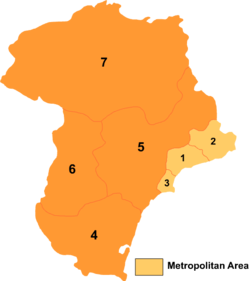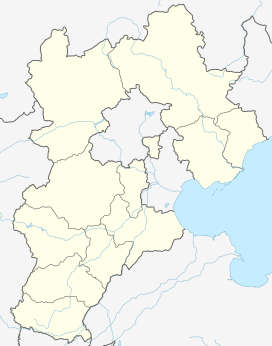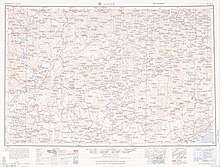Shanhaiguan District
Shanhaiguan District (simplified Chinese: 山海关区; traditional Chinese: 山海關區; pinyin: Shānhǎiguān Qū), formerly Shan-hai-kwan or Shan-hai-kuan, is a district of the city of Qinhuangdao, Hebei Province, China, named after the pass of the Great Wall within the district, Shanhai Pass. It is located 15 kilometres (9.3 mi) east of the city centre.
Shanhaiguan 山海关区 Shanhaikwan | |
|---|---|
.jpg) Shanhaiguan Old Town | |
 Shanhaiguan is the area marked "2" on this map | |
 Shanhaiguan Location in Hebei | |
| Coordinates: 39°58′44″N 119°46′32″E | |
| Country | People's Republic of China |
| Province | Hebei |
| Prefecture-level city | Qinhuangdao |
| Seat | Nanguan Subdistrict |
| Area | |
| • Total | 192 km2 (74 sq mi) |
| Elevation | 2 m (7 ft) |
| Population (2003) | |
| • Total | 140,000 |
| • Density | 730/km2 (1,900/sq mi) |
| Time zone | UTC+8 (China Standard) |
| Postal code | 066200 |
| Area code(s) | 0335 |
| Website | Shanhaiguan.gov.cn |
Administrative divisions

Shanhaiguan (labelled as LIN-YÜ (SHANHAIKWAN) 臨榆 (山海関)) (1951)
Shanhaiguan station
There are five subdistricts, three towns, and one township, Bohai Township (渤海乡), in the district.[1]
Subdistricts
- Nanguan Subdistrict (南关街道)
- Dongjie Subdistrict (东街街道)
- Xijie Subdistrict (西街街道)
- Lunan Subdistrict (路南街道)
- Chuanchang Road Subdistrict (船厂路街道)
Towns
- Diyiguan (第一关镇)
- Shihe (石河镇)
- Mengjiang (孟姜镇)
Climate
The climate is hot-summer humid continental with a monsoon pattern (Dwa:).
| Climate data for Shanhaiguan, China | |||||||||||||
|---|---|---|---|---|---|---|---|---|---|---|---|---|---|
| Month | Jan | Feb | Mar | Apr | May | Jun | Jul | Aug | Sep | Oct | Nov | Dec | Year |
| Average high °C (°F) | 1.6 (34.9) |
4.0 (39.2) |
11.3 (52.3) |
19.8 (67.6) |
26.3 (79.3) |
30.0 (86.0) |
30.7 (87.3) |
30.0 (86.0) |
26.0 (78.8) |
19.6 (67.3) |
10.6 (51.1) |
3.5 (38.3) |
17.8 (64.0) |
| Average low °C (°F) | −7.7 (18.1) |
−5.5 (22.1) |
1.0 (33.8) |
8.5 (47.3) |
14.8 (58.6) |
19.6 (67.3) |
22.7 (72.9) |
22.1 (71.8) |
16.6 (61.9) |
9.6 (49.3) |
1.5 (34.7) |
−5.1 (22.8) |
8.2 (46.7) |
| Average precipitation mm (inches) | 3 (0.1) |
6 (0.2) |
9 (0.4) |
24 (0.9) |
34 (1.3) |
68 (2.7) |
185 (7.3) |
155 (6.1) |
42 (1.7) |
21 (0.8) |
10 (0.4) |
4 (0.2) |
561 (22.1) |
| Average precipitation days (≥ 1) | 2 | 3 | 3 | 5 | 6 | 8 | 13 | 11 | 6 | 5 | 4 | 2 | 68 |
| Source: Hong Kong Observatory (1961-1990)[2] | |||||||||||||
gollark: Not if we locally increase G to arbitrarily large amounts.
gollark: Fortunately, we pack our hashes densely enough into a Merkle tree that the chaotic nature of the N-body problem rapidly breaks those.
gollark: Besides, if you edit the code then the signatures will fail to validate.
gollark: The potatOS privacy policy is the most objective document, so this is unlikely.
gollark: You could not. Correct interpretations are constrained by the potatOS privacy policy.
References
- 山海关区行政区划 (in Chinese)
- "Climatological Information (Reference) for Shanhaiguan, China". Hong Kong Observatory. Retrieved July 4, 2011.
This article is issued from Wikipedia. The text is licensed under Creative Commons - Attribution - Sharealike. Additional terms may apply for the media files.